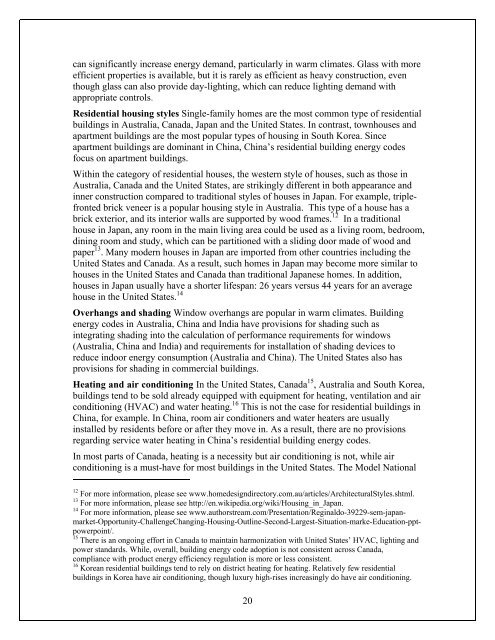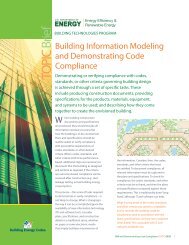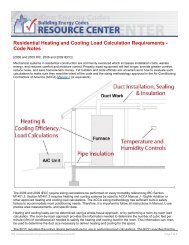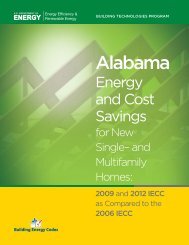can significantly <strong>in</strong>crease energy demand, particularly <strong>in</strong> warm climates. Glass with moreefficient properties is available, but it is rarely as efficient as heavy construction, eventhough glass can also provide day-light<strong>in</strong>g, which can reduce light<strong>in</strong>g demand withappropriate controls.Residential hous<strong>in</strong>g styles S<strong>in</strong>gle-family homes are <strong>the</strong> most common type of residentialbuild<strong>in</strong>gs <strong>in</strong> Australia, Canada, Japan and <strong>the</strong> United States. In contrast, townhouses andapartment build<strong>in</strong>gs are <strong>the</strong> most popular types of hous<strong>in</strong>g <strong>in</strong> South Korea. S<strong>in</strong>ceapartment build<strong>in</strong>gs are dom<strong>in</strong>ant <strong>in</strong> Ch<strong>in</strong>a, Ch<strong>in</strong>a’s residential build<strong>in</strong>g energy codesfocus on apartment build<strong>in</strong>gs.With<strong>in</strong> <strong>the</strong> category of residential houses, <strong>the</strong> western style of houses, such as those <strong>in</strong>Australia, Canada and <strong>the</strong> United States, are strik<strong>in</strong>gly different <strong>in</strong> both appearance and<strong>in</strong>ner construction compared to traditional styles of houses <strong>in</strong> Japan. For example, triplefrontedbrick veneer is a popular hous<strong>in</strong>g style <strong>in</strong> Australia. This type of a house has abrick exterior, and its <strong>in</strong>terior walls are supported by wood frames. 12 In a traditionalhouse <strong>in</strong> Japan, any room <strong>in</strong> <strong>the</strong> ma<strong>in</strong> liv<strong>in</strong>g area could be used as a liv<strong>in</strong>g room, bedroom,d<strong>in</strong><strong>in</strong>g room and study, which can be partitioned with a slid<strong>in</strong>g door made of wood andpaper 13 . Many modern houses <strong>in</strong> Japan are imported from o<strong>the</strong>r countries <strong>in</strong>clud<strong>in</strong>g <strong>the</strong>United States and Canada. As a result, such homes <strong>in</strong> Japan may become more similar tohouses <strong>in</strong> <strong>the</strong> United States and Canada than traditional Japanese homes. In addition,houses <strong>in</strong> Japan usually have a shorter lifespan: 26 years versus 44 years for an averagehouse <strong>in</strong> <strong>the</strong> United States. 14Overhangs and shad<strong>in</strong>g W<strong>in</strong>dow overhangs are popular <strong>in</strong> warm climates. Build<strong>in</strong>genergy codes <strong>in</strong> Australia, Ch<strong>in</strong>a and India have provisions for shad<strong>in</strong>g such as<strong>in</strong>tegrat<strong>in</strong>g shad<strong>in</strong>g <strong>in</strong>to <strong>the</strong> calculation of performance requirements for w<strong>in</strong>dows(Australia, Ch<strong>in</strong>a and India) and requirements for <strong>in</strong>stallation of shad<strong>in</strong>g devices toreduce <strong>in</strong>door energy consumption (Australia and Ch<strong>in</strong>a). The United States also hasprovisions for shad<strong>in</strong>g <strong>in</strong> commercial build<strong>in</strong>gs.Heat<strong>in</strong>g and air condition<strong>in</strong>g In <strong>the</strong> United States, Canada 15 , Australia and South Korea,build<strong>in</strong>gs tend to be sold already equipped with equipment for heat<strong>in</strong>g, ventilation and aircondition<strong>in</strong>g (HVAC) and water heat<strong>in</strong>g. 16 This is not <strong>the</strong> case for residential build<strong>in</strong>gs <strong>in</strong>Ch<strong>in</strong>a, for example. In Ch<strong>in</strong>a, room air conditioners and water heaters are usually<strong>in</strong>stalled by residents before or after <strong>the</strong>y move <strong>in</strong>. As a result, <strong>the</strong>re are no provisionsregard<strong>in</strong>g service water heat<strong>in</strong>g <strong>in</strong> Ch<strong>in</strong>a’s residential build<strong>in</strong>g energy codes.In most parts of Canada, heat<strong>in</strong>g is a necessity but air condition<strong>in</strong>g is not, while aircondition<strong>in</strong>g is a must-have for most build<strong>in</strong>gs <strong>in</strong> <strong>the</strong> United States. The Model National12 For more <strong>in</strong>formation, please see www.homedesigndirectory.com.au/articles/ArchitecturalStyles.shtml.13 For more <strong>in</strong>formation, please see http://en.wikipedia.org/wiki/Hous<strong>in</strong>g_<strong>in</strong>_Japan.14 For more <strong>in</strong>formation, please see www.authorstream.com/Presentation/Reg<strong>in</strong>aldo-39229-sem-japanmarket-Opportunity-ChallengeChang<strong>in</strong>g-Hous<strong>in</strong>g-Outl<strong>in</strong>e-Second-Largest-Situation-marke-Education-pptpowerpo<strong>in</strong>t/.15 There is an ongo<strong>in</strong>g effort <strong>in</strong> Canada to ma<strong>in</strong>ta<strong>in</strong> harmonization with United States’ HVAC, light<strong>in</strong>g andpower standards. While, overall, build<strong>in</strong>g energy code adoption is not consistent across Canada,compliance with product energy efficiency regulation is more or less consistent.16 Korean residential build<strong>in</strong>gs tend to rely on district heat<strong>in</strong>g for heat<strong>in</strong>g. Relatively few residentialbuild<strong>in</strong>gs <strong>in</strong> Korea have air condition<strong>in</strong>g, though luxury high-rises <strong>in</strong>creas<strong>in</strong>gly do have air condition<strong>in</strong>g.20
<strong>Energy</strong> Code of Canada for Build<strong>in</strong>gs (MNECB) and <strong>the</strong> Model National <strong>Energy</strong> Code ofCanada for Houses (MNECH) provide less str<strong>in</strong>gent energy performance requirementswith less comprehensive differentiation <strong>in</strong> types of air condition<strong>in</strong>g equipment comparedto <strong>the</strong> United States standard, ASHRAE 90.1-2007. Air condition<strong>in</strong>g is <strong>in</strong>creas<strong>in</strong>glypopular throughout Asia, but <strong>in</strong> some countries, people are more will<strong>in</strong>g to accept agreater range of <strong>in</strong>door temperatures (hence reduc<strong>in</strong>g <strong>the</strong> energy bill for heat<strong>in</strong>g and aircondition<strong>in</strong>g).Some additional issues Build<strong>in</strong>g orientation is not regulated <strong>in</strong> <strong>the</strong> United States andCanadian build<strong>in</strong>g energy codes, but it is regulated <strong>in</strong> Australia, Ch<strong>in</strong>a, India, Japan andSouth Korea. Ch<strong>in</strong>a, South Korea and Japan recommend that <strong>the</strong> orientation of a hous<strong>in</strong>gunit should face south, for example.Build<strong>in</strong>g energy codes do not conta<strong>in</strong> provisions regard<strong>in</strong>g hous<strong>in</strong>g size, though hous<strong>in</strong>gsize is an important <strong>in</strong>dicator of energy consumption. Average hous<strong>in</strong>g size varies among<strong>the</strong> APP countries.1.8 Climate ZonesSome provisions of build<strong>in</strong>g energy codes, especially <strong>the</strong> <strong>the</strong>rmal characteristics of <strong>the</strong>build<strong>in</strong>g envelope, are grouped by climate zones or geographic locations. For example,a) The Build<strong>in</strong>g Code of Australia (BCA 2007) divides Australia <strong>in</strong>to eight climatezones: 1) high-humidity summer, warm w<strong>in</strong>ter; 2) warm humid summer, mildw<strong>in</strong>ter; 3) hot dry summer, warm w<strong>in</strong>ter; 4) hot dry summer, cool w<strong>in</strong>ter; 5) warmtemperate; 6) mild temperate; 7) cool temperate; and 8) "alp<strong>in</strong>e" area.b) Canada’s MNECB 1997 and MNECH 1997 provide <strong>the</strong>rmal characteristics of <strong>the</strong>build<strong>in</strong>g envelope by its ten prov<strong>in</strong>ces and two territories. 17c) Ch<strong>in</strong>a identifies five climate zones <strong>in</strong> its build<strong>in</strong>g energy codes for commercialbuild<strong>in</strong>gs: 1) severe cold area A, 2) severe cold area B, 3) cold, 4) hot summerand cold w<strong>in</strong>ter (HSCW), and 5) hot summer and warm w<strong>in</strong>ter (HSWW). Ch<strong>in</strong>a’sthree residential build<strong>in</strong>g energy codes focus on three climate zones: 1) heat<strong>in</strong>gzones (a comb<strong>in</strong>ation of severe cold area A and B, and cold); 2) HSCW; and 3)HSWW, respectively.d) The <strong>Energy</strong> Conservation Build<strong>in</strong>g Code (ECBC 2007) divides India <strong>in</strong>to fiveclimate zones: 1) composite, 2) hot and dry, 3) warm and humid, 4) moderate and5) cold.e) In Japan, build<strong>in</strong>g energy codes for commercial build<strong>in</strong>gs are differentiatebetween an ord<strong>in</strong>ary zone (cover<strong>in</strong>g most of Japan), a cold zone (cover<strong>in</strong>g <strong>the</strong> farnorth), and a tropical zone. Build<strong>in</strong>g energy codes for residential build<strong>in</strong>gsprovide requirements for six zones. These zones are based on heat<strong>in</strong>g degree days,so for example zone IV covers areas with an average of 1,500 to 2,500 heat<strong>in</strong>gdegree days per year. This zone covers Tokyo and much of <strong>the</strong> central-sou<strong>the</strong>rnpart of Japan.17 Nei<strong>the</strong>r build<strong>in</strong>g energy code covers Nunavut, a territory that jo<strong>in</strong>ed Canada <strong>in</strong> 1999.21
- Page 1 and 2: PNNL-122267Shaping the Energy Effic
- Page 3: Shaping the Energy Efficiency in Ne
- Page 6 and 7: efficient air conditioning system,
- Page 8 and 9: ContentsForeword ..................
- Page 10 and 11: List of TablesTable 1 GDP, Primary
- Page 12 and 13: ForewordBuildings account for about
- Page 14 and 15: 1 Introduction and Background1.1 Im
- Page 16 and 17: esidential buildings in 2006, with
- Page 18 and 19: JAP 1. Criteria for Clients on the
- Page 22 and 23: f) South Korea’s building energy
- Page 24 and 25: 2.1 AustraliaIn the past, Australia
- Page 26 and 27: small cities will be pilot of such
- Page 28 and 29: (DCGREUH) issued by the Ministry of
- Page 30 and 31: according to the current codes. Thi
- Page 32 and 33: Table 7 Structural Comparison of Bu
- Page 34 and 35: 3.3 Building EnvelopeKey Findings A
- Page 36 and 37: JAPCCREUH1999KORBDCES2008USAASHRAE9
- Page 38 and 39: This study selects the midpoint sco
- Page 40 and 41: MiamiUSA0.36(Insulationabove deck)t
- Page 42 and 43: Six countries have jurisdictions in
- Page 44 and 45: thermal requirements for roofs, flo
- Page 46 and 47: Figure 6 Maximum U-factors in Resid
- Page 48 and 49: Table 16 HVAC in Japan’s Building
- Page 50 and 51: ItemsService water heating refers t
- Page 52 and 53: Water conservation Canada has manda
- Page 54 and 55: practice (MNECB 1997). India sets m
- Page 56 and 57: Canada and India adopt compliance p
- Page 58 and 59: Japan only supervises the building
- Page 60 and 61: 4.2 Testing and RatingKey Findings
- Page 62 and 63: Other commonly used tools among APP
- Page 64 and 65: CAN 55MNECH1997CHNINDECBCJAPCanadia
- Page 66 and 67: and local jurisdiction contact info
- Page 68 and 69: certifying third-party verifiers or
- Page 70 and 71:
Point of ControlIncentives for Comp
- Page 72 and 73:
Point of ControlIncentives for Comp
- Page 74 and 75:
AUS,continuedCANTesting Agencies an
- Page 76 and 77:
CAN,continuedCHNTesting Agencies an
- Page 78 and 79:
Testing Agencies and Certification
- Page 80 and 81:
USA,continuedTesting Agencies and C
- Page 82 and 83:
Appendix C - Compliance SoftwareAUS
- Page 84 and 85:
CANMNECB1997,continuedSoftwareMetho
- Page 86 and 87:
USAIECC 2006,continuedSoftwareMetho
- Page 88 and 89:
AUSBCA 2007,continuedCANMNECB1997CA
- Page 90 and 91:
JAP,ContinuedKORUSAASHRAE90.1-2007T
- Page 92 and 93:
AcronymsAPPAS/NZSASHRAEAUSBATFBCABD
- Page 94 and 95:
ReferencesABCB (Australian Building
- Page 96 and 97:
IEA (International Energy Agency).
- Page 98:
OEE. 2008. Energy Use Data Handbook
















